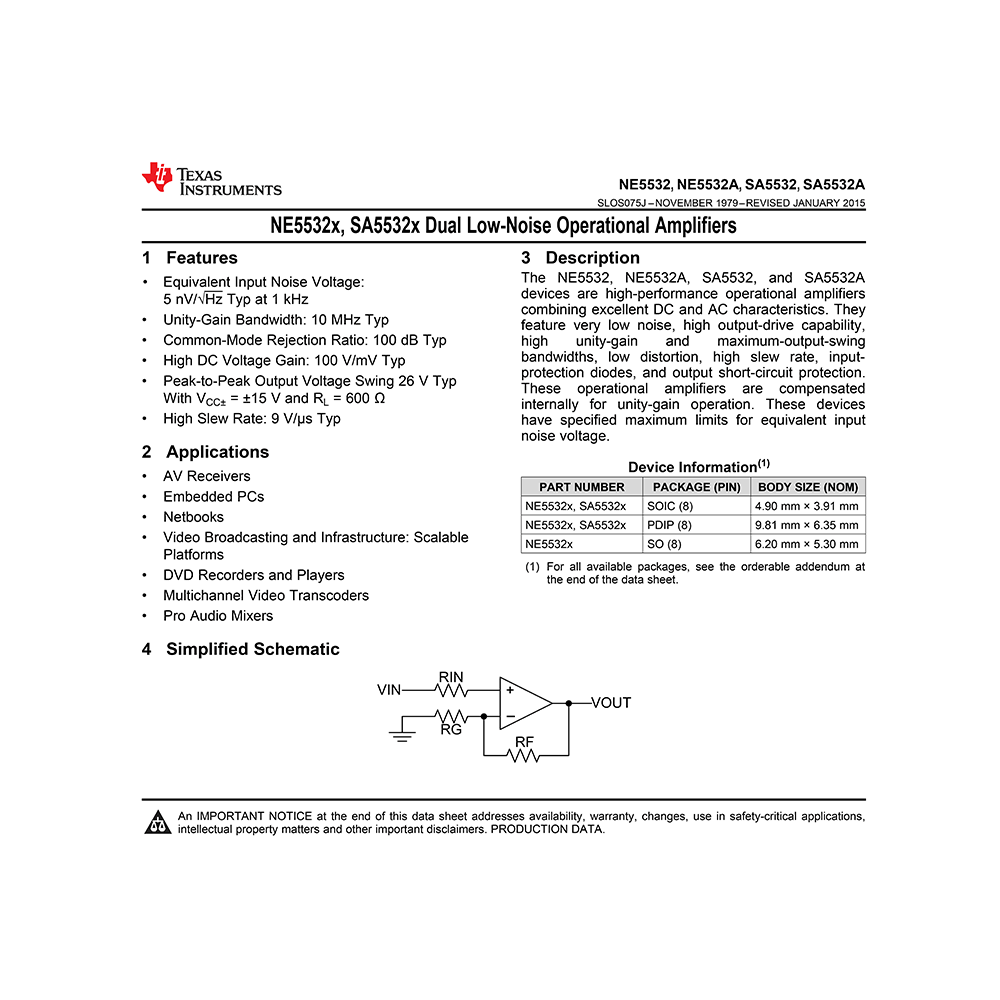SA5532 SA5532A TI Dual Operational Amplifier Data Sheet
Download PDF datasheet for Texas Instruments SA5532 SA5532A Dual Low-Noise Operational Amplifier (EN) 24 pages SLOS075J Rev.J 2015 zip
Description
This PDF datasheet is for the Texas Instruments SA5532 / SA5532A operational amplifier.
About the Item
Texas Instruments SA5532 / SA5532A Dual Low-Noise Operational Amplifier
The SA5532, and SA5532A devices are high-performance operational amplifiers combining excellent dc and ac characteristics.
They feature very low noise, high output-drive capability, high unity-gain and maximum-output-swing bandwidths, low distortion, high slew rate, input-protection diodes, and output shortcircuit protection. These operational amplifiers are compensated internally for unity-gain operation.
These devices have specified maximum limits for equivalent input noise voltage.
(PDF) DATASHEET (ENGLISH)
SUMMARY OF CONTENTS
– Features
– Applications: AV Receivers, Embedded PCs, Netbooks, Video Broadcasting and Infrastructure, DVD Recorders and Players, Multichannel Video Transcoders, Pro Audio Mixers
– Description
– Device Information
– Revision History
– Pin Configuration and Functions
– Pinout
– Specifications
– Maximum Supply voltage
– Maximum Input voltage
– Maximum Input current
– Maximum Duration of output short circuit
– Maximum Operating virtual-junction temperature
– Maximum Storage temperature range
– ESD Ratings
– Recommended Operating Conditions
– Thermal Information
– Electrical Characteristics
– Operating Characteristics
– Typical Characteristics
Figure 1. Equivalent Input Noise Voltage vs Frequency
Figure 2. Equivalent Input Noise Current vs Frequency
Figure 3. Output Swing Bandwidth vs Temperature at Vcc = +/-10 V
– Detailed Description: Functional Block Diagram. Unity-Gain Bandwidth. Common-Mode Rejection Ratio. Slew Rate. Device Functional Modes.
– Application and Implementation
– Typical Application: Design Requirements. Detailed Design Procedure. Application Curves.
Figure 4. Schematic for Single-Ended Input to Differential Output Conversion
Figure 5. Differential Output Voltage vs Input Voltage
Figure 6. Positive Output Voltage Node vs Input Voltage
Figure 7. Positive Output Voltage Node vs Input Voltage
– Power Supply Recommendations
– Layout Guidelines. Layout Example.
– Device and Documentation Support
– Mechanical, Packaging, and Orderable Information
The Signal E-Book SLYT701: A compendium of blog posts on op amp design topics (1Q 2017)
TABLE OF CONTENTS:
I. Op Amp Voltage-Range Issues: Op amp voltage ranges: input and output, clearing some confusion. Rail-to-rail inputs: what you should know. Swinging close to ground: single-supply operation.
II. Offset Voltage: Offset voltage and open-loop gain: they’re cousins. SPICEing offset voltage: how to check the sensitivity of circuits to offset voltage. Where are the trim pins? Some background on offset-voltage trim pins.
III. Input Bias Current: “I need high input impedance!” Input impedance vs. input bias current. Input bias current of CMOS and JFET amplifiers. Temperature effects on input bias current, plus a random quiz. Input bias current cancellation resistors: do you really need them? Internal input bias current cancellation of bipolar op amps.
IV. Stability and Oscillations: Why op amps oscillate: an intuitive look at two frequent causes. Taming the oscillating op amp. Taming oscillations: the capacitive load problem. SPICEing op amp stability. Input capacitance: common mode? Differential? Huh? Op amps: G = 1 stable and decompensated. The inverting attenuator G = -0.1: is it unstable?
V. Dynamic Behavior: Simulating gain bandwidth: the generic op amp model. Slew rate: the op amp speed limit. Settling time: a look at the character of the settling waveform.
VI. Noise: Resistor noise: reviewing basics, plus a fun quiz. Op amp noise: the noninverting amplifier. Op amp noise: but what about the feedback resistors? 1/f noise: the flickering candle. Chopper op amps: are they really noisy?
VII. Other Op Amp Issues: Bypass capacitors: yes, they are needed, but why?. The unused op amp: what to do? Protecting inputs from EOS over-voltage. Differential input clamps: can they affect your op amp circuits? Op amps used as comparators: is it okay?
VIII. More Content: More content and links.
Why download the Datasheet?
This datasheet provides all the information from Texas Instruments about the SA5532 / SA5532A operational amplifier, as detailed in the table of contents. Reading it completely will address most questions you might have. You can download and save it for offline use, including viewing it on your device or printing it for your convenience if you prefer a paper version.
How to download the Datasheet?
Download it by clicking the button below
Helped you out?
Glad to hear that. It would be awesome if you could . . .


